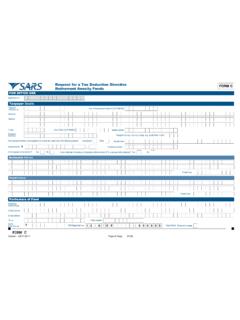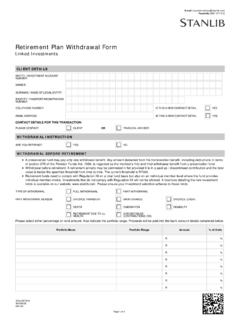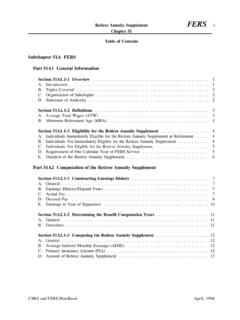Transcription of TIAA Traditional Annuity: Adding safety and stability to ...
1 TIAA Traditional annuity : Adding safety and stability to retirement portfoliosOverviewTeachers Insurance and annuity Association of America (TIAA) was established in 1918 as a legal reserve life insurance company under the insurance laws of the State of New York. Launched in 1918, TIAA Traditional annuity , issued by TIAA, has helped millions of plan participants save for retirement and remains a core holding in many of their retirement portfolios. Considering TIAA Traditional annuity s features, it s not surprising that more participant dollars remain allocated to it than to any other TIAA benefits WSafety and stability . Contributions are backed by the claims-paying ability of TIAA, which has been placed among the highest rated insurance companies in the by three of four leading insurance company rating WCompetitive interest rates. When participants contribute to TIAA Traditional , they will be paid interest at competitive crediting rates which are declared in advance.
2 These rates include a guaranteed minimum rate and the potential to earn WOption to receive guaranteed income for Participants can choose a lifetime-income addition, TIAA Traditional can help offset the effects of market fluctuations on other assets held in a diversified portfolio , and offers many other s insideThis paper explains how TIAA Traditional annuity works, what makes it uniquely attractive as part of a diversified retirement strategy and examines the composition of the investments held in TIAA s General Account the source of the earnings, financial strength and stability that back the guarantees and additional amounts under the TIAA Traditional Traditional annuity : Adding safety and stability to retirement portfolios 2 TIAA Traditional AnnuityThis guaranteed fixed annuity is offered to participants in employer-sponsored retirement plans and to eligible individuals in Individual retirement Accounts (IRAs) through a contract(s) with TIAA.
3 Participants who choose to allocate a portion of their retirement savings to TIAA Traditional annuity make contributions that purchase a specific guaranteed minimum amount of lifetime income based on the contractual rate schedule in effect at the time the premium is participant s principal, plus a specified rate of interest, are guaranteed by TIAA s claims-paying ability. The TIAA Traditional annuity also provides an opportunity for participants to receive additional amounts, which the TIAA Board of Trustees (the Board) may declare on a year-by-year basis. These additional amounts, when declared, remain in effect for the 12-month declaration year that begins each March 1 for accumulating annuities and January 1 for lifetime-payout annuities; they are not guaranteed for future TIAA Traditional annuity is offeredTIAA Traditional annuity is offered through a variety of contracts, including retirement Annuities (RAs), Group retirement Annuities (GRAs), Supplemental retirement Annuities (SRAs), Group Supplemental retirement Annuities (GSRAs), retirement Choice (RC) and retirement Choice Plus (RCP) annuities, IRAs and type of contract through which a participant allocates to the TIAA Traditional annuity determines the applicability of certain account features, such as the guaranteed minimum interest rate, additional amounts paid, the degree of liquidity of the participant s accumulation and the options for receiving income upon paper focuses primarily on RA contracts, although other types of contracts are referenced where appropriate.
4 It summarizes TIAA Traditional annuity s features, discusses valuation and explains other important features of TIAA Traditional annuity rates of returnThere are four primary characteristics of return that are key to understanding and evaluating TIAA Traditional Annuity: 1 Guaranteed principal and minimum interest rateTIAA Traditional annuity guarantees principal and credits contracts a guaranteed minimum interest rate during the accumulation phase generally 3%, but between 1% and 3% for some contracts. These guarantees of principal and minimum interest rates ensure that each participant s accumulation is protected from loss and will always increase in Opportunity to receive additional amountsAs described earlier, additional amounts above the guaranteed minimum interest rate may be declared at the discretion of the Board on a year-by-year basis. Such additional amounts have been paid on in-plan annuities under one or more contracts every year since 1948. In fact, since 1981 the TIAA Traditional total interest crediting rate under retirement annuity and Supplemental retirement annuity contracts has outpaced inflation.
5 When declared, additional amounts remain in effect for the declaration year that begins each March 1, and are not guaranteed for future years. Together, the guaranteed minimum and additional amounts make up the crediting rate in the accumulation phase of the the yields available on bonds and other fixed income investments tend to change over time, TIAA groups the premium dollars it receives over defined time periods into vintages typically composed of one or more contiguous calendar months for the purpose of determining the crediting rate for the applicable declaration year during the accumulation phase. The crediting rate for each vintage is determined, in part, by the net investment earnings rate of the TIAA assets supporting that vintage. In determining the crediting rates we also account for targets for plan and participant servicing expenses, product costs (including amounts associated with managing and maintaining the general account collateral portfolio ), and amounts set aside intended to cover risks and capital charges (referred to as contingency reserves ).
6 The net investment earnings rate associated with each vintage reflects, in part, both the yields at which premiums are invested and the rates at which subsequent cash flows are reinvested. This approach enables TIAA to distribute excess earnings to participants on a more equitable basis, so that each generation will ultimately receive benefit payments that reflect, in part, the prevailing interest-rate environment at the time the crediting rates were Traditional annuity : Adding safety and stability to retirement portfolios 3 Exhibit 1 shows the crediting rate for RA and GRA contracts for the years 1987 through 2017.
7 Over that period, the crediting rate averaged and ranged from a high of in 1987 to a low of in 2010. The declining rate in more recent years is reflective of general interest rate trends. Due to the minimum guarantee, there have been no years in which the crediting rate fell below 3%.Exhibit 1 Trends in key rates spanning three decades: TIAA Traditional crediting rates and 10-year Treasury rates 1987-2017W TIAA crediting rateW10-year Treasury0%3%6%9%12%201420122017201020082 006200420022000199819961994199219901988 The TIAA Traditional annuity crediting rate represents the average rate applied to all accumulations in force under RA and GRA contracts each year. The 10-year Treasury rate represents the annual average of each of the 12 monthly spot rates. Sources: TIAA/Bureau of Labor Statistics (as of the end of 12/31/2017).The graph above is not intended to compare the TIAA Traditional annuity to 10-year Treasury securities. Rather, the graph merely shows the TIAA Traditional annuity s crediting rate alongside general long-term interest rates (for which the 10-year Treasury yield is a common barometer) during the time period shown.
8 It is important to note, however, that there are significant differences between a guaranteed insurance product and Treasuries, and each has its place with regard to addressing an individual investor s needs. Therefore, an investor should not decide between the two based on return alone. There are a number of other factors that must be considered, including the following: (1) different charges and expenses applicable to each, including the mortality and expense charges carried by annuities; (2) liquidity issues (Treasuries are fully liquid while TIAA Traditional is generally not); (3) the manner in which each is taxed, including capital gains implications; (4) the manner in which interest accrues, including the impact of the vintage system on TIAA Traditional returns; and (5) the fact that TIAA Traditional additional amounts are not ensured for future years and may be discontinued, which could significantly diminish the return potential when compared to Treasuries.
9 The TIAA Traditional guarantee is backed by the claims-paying ability of Teachers Insurance and annuity Association of America (TIAA), and the Treasuries are backed by the full faith and credit of the Treasury. TIAA Traditional is a guaranteed annuity Guaranteed minimum annuity payment rate and potential for additional amounts during the annuitization phaseThe third notable feature related to the TIAA Traditional annuity account s returns is that each participant dollar applied to the accumulation purchases a guaranteed minimum amount of lifetime annuity income, paid to participants who choose to annuitize some or all of their balance. Within TIAA Traditional annuity contracts, the interest rate used in the calculation to determine the minimum guaranteed annuity payment amount is at least 2%. As in the accumulation phase, the guaranteed minimum amount may be supplemented by additional amounts declared by the Board on a year-by-year additional amounts reflect earnings in excess of what is necessary to pay the guaranteed minimum amount, as well as a payout of unneeded contingency reserves.
10 As an insurance company, TIAA is required to maintain contingency reserves to ensure that it will be able to fulfill its contractual obligations to policyholders, even in the face of unexpected adverse circumstances. However, to the extent that these reserves prove to be unneeded, they are gradually distributed to participants in the form of additional annuity income at the time of retirement and during the period of time the participant is receiving annuity income after retirement . (It is important to note that if TIAA were a typical stock insurance company, unneeded reserves could be used for the benefit of its stockholders rather than its participants.)4 Long time horizon to enable competitive returnsThe fourth important characteristic related to the TIAA Traditional annuity s return is related to the level of liquidity provided for under each contract. TIAA has credited more to participants who save in contracts where benefits are paid in installments over time instead of in an immediate lump-sum by crediting higher interest rates, typically to higher.


















